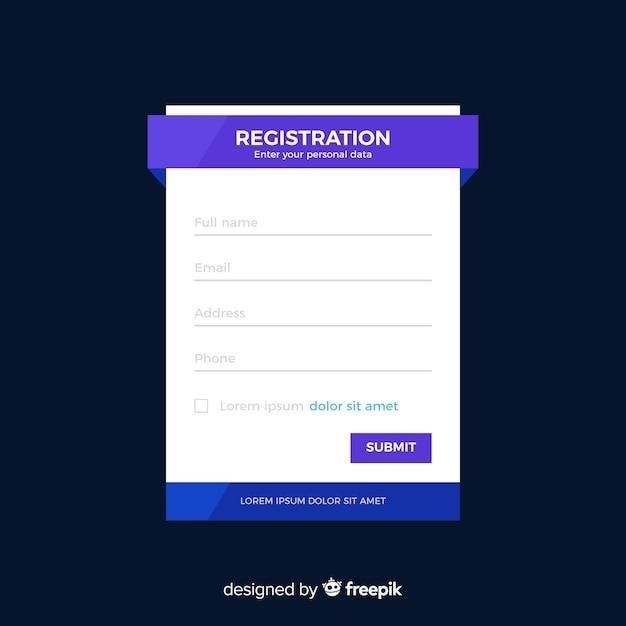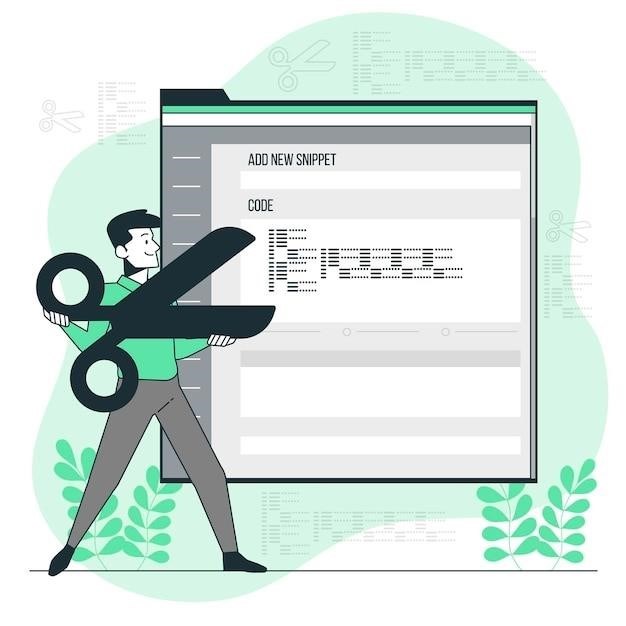Introduction to Tutorial Request Forms
Tutorial Request Forms (TRFs) are essential tools for students seeking additional academic support. They provide a structured method for students to articulate their learning needs, allowing educators to tailor their assistance effectively.
What is a Tutorial Request Form (TRF)?
A Tutorial Request Form (TRF) is a digital form that empowers students to request extra help with specific subjects or topics. It acts as a bridge between students and teachers, facilitating a structured approach to seeking academic support. TRFs are commonly used in AVID (Advancement Via Individual Determination) programs, where students actively participate in tutorials twice a week. The form serves as a formal request for assistance, allowing students to clearly outline their areas of difficulty and desired learning outcomes.
Purpose of Tutorial Request Forms
Tutorial Request Forms (TRFs) play a crucial role in fostering a supportive learning environment. Their primary purpose is to enhance student engagement by providing a clear channel for students to seek assistance and clarify their understanding of complex concepts. By encouraging students to articulate their learning needs, TRFs facilitate targeted academic support, ensuring that educators can address specific points of confusion and tailor their instruction accordingly. This personalized approach helps students develop a deeper understanding of the material and ultimately leads to improved learning outcomes.
Components of a Tutorial Request Form
A well-structured Tutorial Request Form (TRF) includes key elements that help students effectively communicate their learning needs.
Subject and Topic
The “Subject and Topic” section of a Tutorial Request Form (TRF) is crucial for identifying the specific area of study requiring support. Students should clearly state the subject matter, such as “Math,” “English,” or “Science,” followed by a brief description of the specific topic within that subject. For example, a student might indicate “Algebra” under “Math” or “Shakespearean Literature” under “English.” This clarity allows educators to understand the student’s learning needs and provide targeted assistance.
Point of Confusion
The “Point of Confusion” section of a Tutorial Request Form (TRF) is where students articulate the specific areas of difficulty they are experiencing. This section encourages students to be precise about their challenges. For example, a student might write, “I am confused about the concept of factoring quadratic equations,” or “I don’t understand how to write a persuasive essay.” By clearly outlining their confusion, students provide valuable information to educators, enabling them to tailor their support and address the specific areas where the student needs help.
Specific Tutorial Question
The “Specific Tutorial Question” section of a TRF serves as a bridge between the student’s confusion and their desired learning outcomes. This section requires students to formulate a concise, focused question that directly addresses their point of confusion. For example, a student might ask, “What are the steps involved in factoring a quadratic equation?” or “Can you provide an example of a persuasive essay and explain how it uses evidence effectively?” By articulating a specific question, students demonstrate their understanding of their learning needs and guide the tutor towards providing targeted support.
Desired Learning Outcomes
The “Desired Learning Outcomes” section of a TRF is crucial for setting clear goals for the tutorial session. Here, students articulate what they hope to achieve by the end of the tutorial. This section encourages students to think beyond simply understanding the point of confusion and to envision how the acquired knowledge will benefit their overall learning. For instance, a student might state, “I want to be able to solve quadratic equations without relying on a calculator,” or “I want to understand how to write a persuasive essay that effectively uses evidence to support its argument.” By specifying desired learning outcomes, students ensure the tutorial focuses on their specific needs and promotes meaningful progress.

Filling Out a Tutorial Request Form
Completing a Tutorial Request Form (TRF) is a straightforward process that empowers students to seek targeted academic support.
Identifying the Point of Confusion
The first step in filling out a Tutorial Request Form (TRF) is to pinpoint the specific area where you’re experiencing difficulty. This involves reflecting on the material you’ve learned and identifying the concept or skill that’s causing you confusion. For instance, if you’re struggling with a math problem, you might ask yourself⁚ “What specific operation or formula am I having trouble understanding?” or “What are the steps I’m getting stuck on?” By clearly defining the source of your confusion, you provide valuable context for the tutor, enabling them to offer more focused and relevant assistance.
Formulating a Specific Question
Once you’ve identified the point of confusion, the next step is to craft a clear and concise question that accurately reflects your need for help. A well-formulated question serves as a roadmap for the tutor, guiding them directly to the area you require assistance with. Instead of broad inquiries like “Can you explain this chapter?” aim for specific questions like “What is the difference between a TRF and a tutorial?” or “How do you complete a tutorial request form?” This level of precision ensures that the tutor can address your specific query effectively.
Requesting Specific Support
The Tutorial Request Form (TRF) goes beyond simply stating a question; it allows you to request specific types of support tailored to your learning style. For example, you might indicate whether you prefer individual tutoring, small group sessions, or online resources. You can also specify desired learning outcomes, such as understanding a specific concept, applying a skill, or completing a particular assignment. This level of detail ensures that the tutor can provide the most effective assistance, maximizing your chances of achieving your desired learning goals.
Benefits of Using Tutorial Request Forms
Tutorial Request Forms streamline the process of seeking academic assistance, leading to more efficient and effective support.
Enhanced Student Engagement
Tutorial Request Forms empower students to take ownership of their learning journey. By actively identifying areas of confusion and formulating specific questions, students become more engaged in the learning process. This sense of ownership fosters a proactive mindset, encouraging students to seek support before challenges become overwhelming. Moreover, the process of completing a TRF encourages critical thinking and reflection, prompting students to analyze their understanding and pinpoint specific areas requiring clarification. This self-directed approach leads to deeper comprehension and a more meaningful learning experience.
Targeted Academic Support
Tutorial Request Forms serve as a valuable communication tool between students and educators. By outlining specific areas of confusion and desired learning outcomes, students provide educators with a clear understanding of their individual needs. This allows educators to tailor their support to address specific learning gaps, ensuring that students receive the most relevant and effective assistance. TRFs facilitate a personalized approach to academic support, maximizing the impact of tutoring sessions and ensuring that students receive the targeted guidance they require to succeed.
Improved Learning Outcomes
By fostering a culture of proactive learning and providing targeted support, Tutorial Request Forms contribute directly to improved learning outcomes. Students who utilize TRFs are more likely to identify and address their learning challenges before they become significant obstacles. This proactive approach allows for timely intervention, preventing knowledge gaps from accumulating and hindering future learning. Additionally, the focused nature of TRFs ensures that tutoring sessions are directly relevant to the student’s needs, maximizing the efficiency and effectiveness of the support provided. As a result, students are better equipped to grasp concepts, develop critical thinking skills, and achieve their academic goals.

Examples of Tutorial Request Forms
The format and content of Tutorial Request Forms can vary widely, catering to different learning environments and pedagogical approaches.
AVID Style Tutorial Request Form
The AVID (Advancement Via Individual Determination) style Tutorial Request Form is a widely adopted format in educational settings. This form typically includes sections for the student to specify the subject, essential question, point of confusion, and desired learning outcomes. It encourages students to articulate their specific needs and provides a clear framework for tutors to understand and address them. The form often features a pre-work inquiry section, prompting students to reflect on their existing knowledge and identify areas where they require further support. The AVID style TRF promotes active student engagement and fosters a collaborative learning environment.
Interactive Tutorial Request Form
Interactive Tutorial Request Forms leverage technology to enhance the process of seeking academic assistance. These forms often utilize online platforms or software that allow students to submit their requests electronically. They may include features like dropdown menus, multiple-choice questions, and text boxes to facilitate a more streamlined and efficient process. Interactive forms can also incorporate elements like progress bars, timelines, and notification systems to keep students informed about the status of their requests and the availability of tutors. The interactive nature of these forms promotes student engagement and facilitates a more personalized and efficient learning experience.
Pre-work Inquiry Form
Pre-work Inquiry Forms are designed to encourage proactive learning and prepare students for upcoming tutorials. These forms are typically completed before a scheduled tutoring session and serve as a pre-assessment tool. They may ask students to identify the specific topics they’ll be focusing on during the tutorial, reflect on their prior understanding, and outline any questions they have. The form can also include space for students to summarize any relevant information or materials they’ve already reviewed. By completing this pre-work inquiry, students demonstrate their initiative and commitment to the learning process, which can lead to more focused and productive tutoring sessions.
Effective Tutorial Request Forms are crucial for fostering academic growth and ensuring targeted support.
The Importance of Effective Tutorial Request Forms
Well-crafted Tutorial Request Forms (TRFs) play a vital role in facilitating successful academic support. They act as a bridge between students and educators, ensuring clear communication of learning needs and allowing for personalized assistance. When students articulate their challenges and desired outcomes effectively through a TRF, educators can provide tailored guidance, addressing specific points of confusion and fostering deeper understanding. This targeted approach enhances student engagement, optimizes learning outcomes, and creates a supportive environment conducive to academic growth.
Tips for Optimizing Tutorial Request Forms
To maximize the effectiveness of Tutorial Request Forms (TRFs), consider these key optimization strategies⁚
- Clarity and Conciseness⁚ Design the form with clear and concise language, ensuring students can easily understand each section and provide accurate information.
- Specific Guidance⁚ Offer prompts and examples within each section, guiding students to articulate their needs effectively. For instance, provide suggestions for formulating specific questions or outlining desired learning outcomes.
- Accessibility and Format⁚ Ensure the form is accessible to all students, offering options for different learning styles and providing accommodations as needed. Consider incorporating digital formats for ease of use and submission.
- Regular Review and Feedback⁚ Periodically review the form’s effectiveness with students and educators, gathering feedback to identify areas for improvement and ensure it remains relevant and helpful.
By implementing these tips, educators can create Tutorial Request Forms that empower students, foster successful learning, and enhance the overall effectiveness of academic support initiatives.



